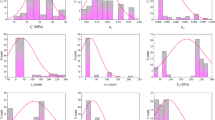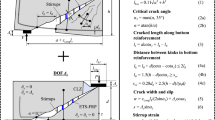Abstract
The torsional behavior of RC beams is a complex work involving interactions of different design parameters and mechanisms. Considering the limitations and lower accuracy of traditional calculation theories, two machine learning models, including artificial neural network (ANN) model and random forest (RF) model, were applied for the first time to predict the cracking torque and initial or pre-cracking torsional stiffness of RC beams. A comprehensive database consisting 159 experimental results of RC beams with solid or hollow sections was compiled, with input variables including dimension parameters of cross-section, compressive stress of concrete, elastic modulus and strength ratio of reinforcements. The performance of the models was appraised by various statistical estimators and safety ratio, and compared with different theories for cracking torque and initial stiffness. Among all the calculation models, RF model achieved the best overall prediction performance with the highest coefficient of determination (R2 = 0.985 for cracking torque and R2 = 0.978 for initial stiffness) and lowest root-mean-square error (RMSE = 5.867 for cracking torque and RMSE = 3.994 for initial stiffness). However, theories for cracking torque, i.e., plastic theory, Bredt thin-tube theory and skew-bending theory, gave huge underestimation, whereas greatly exaggerated initial stiffness was obtained by elastic theory and simplified soften membrane model for torsion theory. Besides, input variable importance analysis was conducted, revealing that dimension parameters of cross-section were the most critical features to decide prediction performance for pre-cracking torsional performance of RC beams. The achievements of this paper may provide references to the establishment of new predicting model for pre-cracking torsional response of RC beams.













Similar content being viewed by others
References
Kuan A, Bruun EPG, Bentz EC, Collins MP. Nonlinear sectional analysis of reinforced concrete beams and shells subjected to pure torsion. Comput Struct. 2019;222:118–32.
Peng X-N, Wong Y-L. Behavior of reinforced concrete walls subjected to monotonic pure torsion—an experimental study. Eng Struct. 2011;33:2495–508.
Chen S, Xie Q, Gao F. Calculation method of cracking loads of U-shaped thin-walled RC members subjected to eccentric loading. IOP Conf Ser: Earth Environ Sci. 2019;304:052036.
Kim C, Kim S, Kim K-H, Shin D, Haroon M, Lee J-Y. Torsional behavior of reinforced concrete beams with high-strength steel bars. ACI Struct J. 2019;116:251–63.
Joh C, Kwahk I, Lee J, Yang I-H, Kim B-S. Torsional behavior of high-strength concrete beams with minimum reinforcement ratio. Advances in Civil Engineering. 2019;2019:1–11.
Mcmullen AE, Rangan BV. Pure tension in rectangular sections—a re-examination. ACI J. 1978;75:511–9.
Mitchell D, Collins MP. Diagonal compression field theory-a rational model for structural concrete in pure torsion. ACI Journal Proceedings. 1974;71:396–408.
Bernardo L, Andrade J, Lopes S. Modified variable angle truss-model for torsion in reinforced concrete beams. Mater Struct. 2012;45:1877–902.
Bernardo LFA, Lopes SMR. Behaviour of concrete beams under torsion: NSC plain and hollow beams. Mater Struct. 2008;41:1143–67.
Bernardo LFA, Andrade JMA. A unified softened truss model for RC and PC beams under torsion. J Build Eng. 2020;32: 101467.
Bernardo L, Andrade J, Lopes S. Softened truss model for reinforced NSC and HSC beams under torsion: a comparative study. Eng Struct. 2012;42:278–96.
Hsu TT, Mo Y. Softening of concrete in torsional members-design recommendations. ACI J Proc. 1985;82:443–52.
Hsu TT, Mo Y. Softening of concrete in torsional members-theroy and tests. ACI J Proc. 1985;82:290–303.
Jeng C-H. Unified softened membrane model for torsion in hollow and solid reinforced concrete members: modeling precracking and postcracking behavior. J Struct Eng. 2015;141:04014243.
Karayannis CG. Smeared crack analysis for plain concrete in torsion. J Struct Eng. 2000;126:638–45.
Karayannis CG, Chalioris CE. Experimental validation of smeared analysis for plain concrete in torsion. J Struct Eng. 2000;126:646–53.
GB50010. Code for design of concrete structures. Beijing: China Architecture & Building Press 2016.
Bernardo LFA, Lopes SMR. Theoretical behavior of HSC sections under torsion. Eng Struct. 2011;33:3702–14.
Jeng CH. Softened membrane model for torsion in reinforced concrete members. Advance in engineering research. 2012;2:251–338.
Jeng C-H, Hsu TT. A softened membrane model for torsion in reinforced concrete members. Eng Struct. 2009;31:1944–54.
Jeng C-H, Chao M. Unified rational formula for pre-cracking torsional stiffness of solid and hollow reinforced concrete members. Eng Struct. 2015;99:92–107.
Jeng CH. Simple Rational Formulas for Cracking Torque and Twist of Reinforced Concrete Members. ACI Struct J. 2010;107:189–98.
Sony S, Dunphy K, Sadhu A, Capretz M. A systematic review of convolutional neural network-based structural condition assessment techniques. Eng Struct. 2021;226: 111347.
Sun H, Burton HV, Huang H. Machine learning applications for building structural design and performance assessment: State-of-the-art review. J Build Eng. 2021;33: 101816.
Charalampakis AE, Papanikolaou VK. Machine learning design of R/C columns. Eng Struct. 2021;226: 111412.
Firouzi A, Abdolhosseini M, Ayazian R. Service life prediction of corrosion-affected reinforced concrete columns based on time-dependent reliability analysis. Eng Fail Anal. 2020;117: 104944.
Azimi M, Eslamlou AD, Pekcan G. Data-driven structural health monitoring and damage detection through deep learning: state-of-the-art review. Sensors. 2020;20:2778.
Xu J-G, Hong W, Zhang J, Hou S-T, Wu G. Seismic performance assessment of corroded RC columns based on data-driven machine-learning approach. Eng Struct. 2022;255: 113936.
Yan W, Deng L, Zhang F, Li T, Li S. Probabilistic machine learning approach to bridge fatigue failure analysis due to vehicular overloading. Eng Struct. 2019;193:91–9.
Dissanayake M, Nguyen H, Poologanathan K, Perampalam G, Upasiri I, Rajanayagam H, et al. Prediction of shear capacity of steel channel sections using machine learning algorithms. Thin-Walled Struct. 2022;175: 109152.
Truong GT, Hwang H-J, Kim C-S. Assessment of punching shear strength of FRP-RC slab-column connections using machine learning algorithms. Eng Struct. 2022;255: 113898.
Marani A, Nehdi ML. Predicting shear strength of FRP-reinforced concrete beams using novel synthetic data driven deep learning. Eng Struct. 2022;257: 114083.
Rahman J, Ahmed KS, Khan NI, Islam K, Mangalathu S. Data-driven shear strength prediction of steel fiber reinforced concrete beams using machine learning approach. Eng Struct. 2021;233: 111743.
Olalusi OB, Awoyera PO. Shear capacity prediction of slender reinforced concrete structures with steel fibers using machine learning. Eng Struct. 2021;227: 111470.
Lu S, Koopialipoor M, Asteris PG, Bahri M, Armaghani DJ. A Novel feature selection approach based on tree models for evaluating the punching shear capacity of steel fiber-reinforced concrete flat slabs. Materials. 2020;13:3902.
Arslan MH. Predicting of torsional strength of RC beams by using different artificial neural network algorithms and building codes. Adv Eng Softw. 2010;41:946–55.
Haroon M, Koo S, Shin D, Kim C. Torsional behavior evaluation of reinforced concrete beams using artificial neural network. Appl Sci. 2021;11:4465.
Ilkhani MH, Naderpour H, Kheyroddin A. A proposed novel approach for torsional strength prediction of RC beams. J Build Eng. 2019;25: 100810.
Breiman L. Random forests. Mach Learn. 2001;45:5–32.
Kim C, Lee J-Y, Kim M. Prediction of the dynamic stiffness of resilient materials using artificial neural network (ANN) technique. Appl Sci. 2019;9:1088.
Wu CL, Chau KW, Li YS. Methods to improve neural network performance in daily flows prediction. J Hydrol. 2009;372:80–93.
Perera R, Arteaga A, Diego AD. Artificial intelligence techniques for prediction of the capacity of RC beams strengthened in shear with external FRP reinforcement. Compos Struct. 2010;92:1169–75.
Scornet E. Random forests and Kernel methods. IEEE Trans Inf Theory. 2016;62:1485–500.
Bernardo LFA, Andrade JMA, Nunes NCG. Generalized softened variable angle truss-model for reinforced concrete beams under torsion. Mater Struct. 2015;48:2169–93.
Jeng C-H. Unified softened membrane model for torsion in hollow and solid reinforced concrete members: modeling precracking and postcracking behavior. J Struct Eng. 2014;141:04014243.
Bernardo LF, Lopes SM. Torsion in high-strength concrete hollow beams: strength and ductility analysis. ACI Struct J. 2009;106:39–48.
Chalioris CE. Experimental study of the torsion of reinforced concrete members. Struct Eng Mech. 2006;23:713–37.
Shiau FJKJASJ. Torsional behavior of normal- and high-strength concrete beams. ACI Struct J. 2004;101:304–13.
Hsu TT. Torsion of structural concrete—behavior of reinforced concrete rectangular members. American Concrete Institute. 1968;18:261–306.
Hsu TT, Mo Y-L. Unified theory of concrete structures. Hoboken: John Wiley & Sons; 2010.
Paluszek M, Thomas S. MATLAB machine learning recipes: a problem-solution approach. Berkeley: Apress; 2019.
Zakir Sarothi S, Sakil Ahmed K, Imtiaz Khan N, Ahmed A, Nehdi ML. Predicting bearing capacity of double shear bolted connections using machine learning. Eng Struct. 2022;251: 113497.
ACI318–19. Building code requirements for structural concrete and commentary American Concrete Institute USA; 2019.
Eurocode2. Design of concrete structures. Part 1-general rules and rules for buildings. 2004.
Chen S, Ye Y, Guo Q, Cheng S, Diao B. Nonlinear model to predict the torsional response of U-shaped thin-walled RC members. Struct Eng Mech. 2016;60:1039–61.
Kang M-C, Yoo D-Y, Gupta R. Machine learning-based prediction for compressive and flexural strengths of steel fiber-reinforced concrete. Constr Build Mater. 2021;266: 121117.
Pei Z, Zhang D, Zhi Y, Yang T, Jin L, Fu D, et al. Towards understanding and prediction of atmospheric corrosion of an Fe/Cu corrosion sensor via machine learning. Corros Sci. 2020;170: 108697.
Olalusi OB, Spyridis P. Uncertainty modelling and analysis of the concrete edge breakout resistance of single anchors in shear. Eng Struct. 2020;222: 111112.
Acknowledgements
This work was supported by the National Natural Science Foundation of China [Grant number 51808258], CSCEC Technical and Development Plan [Grant No. CSCEC-2020-Z-35], and Fundamental Research Funds for the Central Universities [Grant No. 2022QN1031].
Author information
Authors and Affiliations
Corresponding author
Ethics declarations
Conflict of interest
The authors declared that we have no conflicts of interest to this work. We declare that we do not have any commercial or associative interest that represents a conflict of interest in connection with the work submitted.
Ethical approval
This article does not contain any studies with human participants or animals performed by any of the authors. This study was done according to ethical standards.
Additional information
Publisher's Note
Springer Nature remains neutral with regard to jurisdictional claims in published maps and institutional affiliations.
Supplementary Information
Below is the link to the electronic supplementary material.
Rights and permissions
Springer Nature or its licensor holds exclusive rights to this article under a publishing agreement with the author(s) or other rightsholder(s); author self-archiving of the accepted manuscript version of this article is solely governed by the terms of such publishing agreement and applicable law.
About this article
Cite this article
Shenggang, C., Quanquan, G., Yingying, Z. et al. Machine learning models for cracking torque and pre-cracking stiffness of RC beams. Archiv.Civ.Mech.Eng 23, 6 (2023). https://doi.org/10.1007/s43452-022-00541-2
Received:
Revised:
Accepted:
Published:
DOI: https://doi.org/10.1007/s43452-022-00541-2




